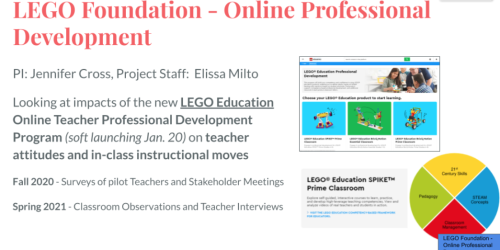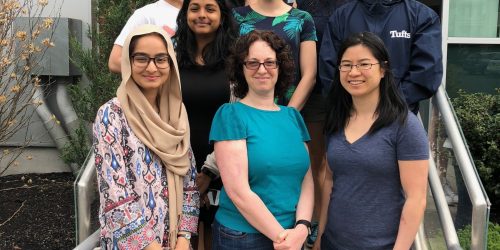by Sara Willner-Giwerc, Doctoral Student in Mechanical Engineering
In the spring of 2018, I (Sara Willner-Giwerc) took a course called The Global Educator from Professor Linda Beardsley. The course was focused on the education system of post-colonial Africa and the impact the colonization had in the educational system across the continent. Specifically, we studied the education system in Rwanda, a country with a complicated history and a rapidly developing school system. Professor Beardsley is also the head of the Education Committee for the Maranyundo Initiative, which helped start and now supports the Maranyundo Girls School (MGS). The Maranyundo Girls School is a high performing secondary boarding school in Rwanda providing a science and technology focused education for girls from across Rwanda. This private, secular school is located in the poorest district in Rwanda, which is where the highest percentage of their students come from. They currently enroll 400 girls from all over Rwanda, of which half receive scholarships. You can read more about MGS and the Maranyundo Initiative here.
In March of 2019 I traveled to the Maranyundo Girls School to help them set up a makerspace and implement hands on learning experiences for their students. MGS is owned and run by the Benabikra nuns, and Sister Juvenal is the headmistress of the school. A large STEM Learning Center/Library building was constructed in 2017 but is mostly empty with the exception of the school library. Sister Juvenal allocated two rooms in the STEM center to be “makerspaces”: a place to house technology and space for the girls to engage in hands on, STEM-themed learning experiences.
While MGS is a STEM school (students can pick from 4 combinations of STEM subjects to focus on), there is little to no hands on learning experiences available for students. The goal of my trip was to bring a few different types of materials that could be used to learn STEM concepts experientially and help train students and teachers on how to use the materials.
The problems I ran into at MGS were many of the same problems schools around the world face when trying to implement hands on learning opportunities for students. Teachers at MGS are under a lot of pressure to teach to the national curriculum so that students will be prepared for their national exams. Trying to find time to deviate from the scripted content is stressful and often seems impossible. The added barrier of introducing an unfamiliar technology or new pedagogy is also intimidating for teachers.
There was also an abundance of technology already present at MGS when I arrived. However, most of it was unused. A set of about 30 iPads were essentially useless because they were donated to the school with someone’s personal apple ID and password on them. This means that the students and teachers have no way to download applications, rendering the iPads essentially useless. Additionally, there were 100 laptops that were given to the school by the Rwandan Education Board. However, nobody knew what the administrator password was, making it impossible to download any software onto those iPads. While there are many free, cloud based softwares that could still have been used, the internet required for those tools was not readily available at MGS. While there is WiFi access, it is a data-based system, which means downloading programs is time-consuming (can take several days) and expensive. Once all of the data is used up for the day (usually happened by noon), there is no more internet access until the data cycle starts the following day.
There were two LEGO MINDSTORMS NXT sets at MGS, but they were unusable because the batteries had been plugged in to charge without a voltage adapter. Since outlets in Rwanda output 220V (as opposed to the 110V in the United States), the batteries were fried, rendering them unusable. They also didn’t have the software, and weren’t able to download it due to the WiFi problems.
A Pursa 3D printer was also sitting unused in a box because the administrators/teachers were unsure how to set it up. This same exact situation was present at one of the other schools I visited, where 3D printers were unused because nobody new how to get started, and downloading the software (even though it is free) is essentially impossible. The STEM building at MGS is solar powered, which means that once the sun goes down the electricity goes out. In many maker-spaces, the 3D printers are left printing all night. However, this is not an option for MGS because once the sun sets the power in the STEM building goes out.
Despite all of the technological mismatches, I was able to copy entire programs I had installed on my personal computer onto flashdrives, and the students were able to run applications directly from the flash drives on the school computers. Students used the LEGO WeDo sets using NetGear tablets to build simple robots. For the majority of the students and teachers it was the first time they had ever put two LEGO bricks together or controlled a motor of any kind. Watching students and teachers put their first LEGO bricks together and build their first robots was a special experience.
I also taught the girls OnShape (cloud based CAD platform), and they picked it up super quickly. They 3D printed all sorts of objects to help solve problems around the school, like a holder for chalk that hangs on the back of a chair. They quickly picked up any kind of hands on activity that involved solving a concrete problem, but struggled to do activities that involved more exploration/play. Convincing them to make paper stomp rockets (rockets that launch by stomping on a pump that pushes a gust of air through a tube) was nearly impossible because they didn’t want to waste paper and couldn’t see how that would help them learn. However, they loved building/telling stories with the LEGO bricks, designing objects to 3D print, and building robots. They also began exploring with the BBC Micro:bit, and Makey-Makey kits, but use was limited by the lack of wifi connection.
Overall this was a really great learning opportunity about the different types of barriers to entry to using technology. I hope to continue to work closely with the teachers and students at the Maranyundo school to help incorporate more hands on learning and learning through play into their everyday curriculum. I am also hoping to work with FAWE (Forum for African Women Educationalists) to map the Rwandan National Curriculum standards to relevant hands on experiences that could be easily implemented across the country. Understanding the classrooms you are designing for and how to make technology that works out of the box no matter where in the world it is being used is a big challenges, and as I continue to work on the design of educational technologies and learning experiences I will keep Maranyundo and all of the challenges and successes I had their in mind.







